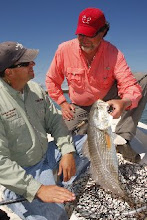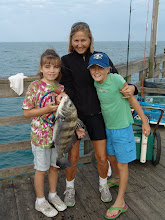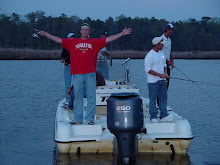CFRG 5-POINT PROPOSAL TO REDUCE TRAWLER BY CATCH
North Carolina once had a recreational fishery that was second to none and a source of great pride to our state. Today this fishery pales in comparison to what it once was and many of our fish species are now depleted from years of overfishing. In 1998, a study on shrimp trawling by the National Marine Fisheries Service was reported to the U.S. Congress (1). It showed that in 5695 tows by shrimp trawlers, an average of 4.5 pounds of bycatch occurred for every pound of shrimp that was harvested. Most of the bycatch consisted of small finfish such as croaker, spot, and weakfish. This study opened many eyes and caused states all along the Atlantic and Gulf coasts to begin enacting rules to try to lessen shrimp trawl bycatch. The result over several years was that out of eight shrimp-producing states in this region, four eliminated commercial trawling in inshore waters (GA, SC, TX, and FL), and three severely restricted it via head rope size (LA, AL, and MS). That left North Carolina as the only state to allow virtually unrestricted shrimp trawling to occur in inshore waters. While others heeded the national study and enacted measures to protect their fish nurseries, North Carolina trawled on.
Recently, the North Carolina Division of Marine Fisheries (NCDMF) repeated the national trawler study in North Carolina waters by analyzing bycatch from 505 tows by commercial shrimp trawlers (2, 3). As one might expect, the end result was very similar to the prior study with an average bycatch to shrimp ratio of 3.6 to 1 (by weight). As was seen before, most of the bycatch consisted of young croaker, spot, and weakfish. Part of the North Carolina study added a new piece of information by counting individual species in addition to weighing them. This fish count produced another eye opening result. The juvenile finfish were small and had an average weight of between 20-30 fish per pound. Some simple math revealed that over the last five years, North Carolina’s average shrimp harvest of just over 7 million pounds per year was causing approximately 25 million pounds of bycatch per year. Astonishingly, at the lower estimate of 20 fish per pound, this would extrapolate to an average of approximately 500 million small fish being killed
every year! Even more astonishing was the fact that this result was expected and was considered as “nothing new” by those who have studied this problem for years.
In spite of knowing all of this, and with new studies in hand, the NCDMF recommended a “revision” of the shrimp management plan. This meant that the management plan would continue on with no substantial changes to address the problem of bycatch. The NCDMF also recommended additional studies on the issue of bycatch, even though they had just completed a large study that had results similar to those reported by the larger national study. In the time since that recommendation was made several months ago, the news of the results of the bycatch studies spread and the public outcry has grown louder with recreational fishermen demanding that the shrimp management plan be “amended” to allow rule changes that would lessen bycatch. More studies are not needed, it is simply time to act upon the data we already have.
While an amendment to the shrimp management plan is being considered, the Coastal Fisheries Reform Group (CFRG), which represents recreational fishermen in North Carolina, is requesting that immediate changes be implemented. These changes can be made without delay by using the power of proclamation at the February 2013 Marine Fisheries Commission (MFC) meeting. A proclamation can be used because the third most abundant finfish species in our bycatch is the weakfish (grey trout). The NCDMF studies indicate that tens of millions of juvenile weakfish are killed in our shrimp trawlers every year. While we waste these fish, they are sadly classified as depleted after being severely overfished for many years. The MFC and NCDMF can act immediately by proclamation to protect any fish that is in such bad shape and they must not delay. It should also be noted that lessening weakfish deaths in bycatch will also lessen the destruction of croaker and spot, two species which have also greatly declined after once being a plentiful and popular target of recreational fisherman. These fish all need protection now and the CFRG proposes the following changes to address the unacceptably large loss of juvenile finfish that occurs during shrimp trawling:
1. Limit all trawl nets in inshore coastal waters to a maximum headrope size of 35 feet and only allow one net per boat. This would remove the large nets and their excessive bycatch but would allow the small trawlers that have shrimped in our sounds for generations to continue working uninterrupted. These boats are mostly local boats, with local crews that sell their catch at local fish houses in North Carolina. Such a rule change would greatly benefit the vast majority of North Carolina shrimpers while truly helping our coastal economies and our marine resources.
2. Limit tow times to 45 minutes. This would allow for some bycatch to be released alive and also increase the chance of sparing any endangered turtles which are entrapped in the net.
3. Delay shrimp season until the shrimp size has reached the level of having 36 to 41 (or lower) shrimp per pound. This would postpone the harvest of shrimp and allow juvenile finfish to grow larger and have more of a chance of escaping shrimp trawls. These fish would also have more time to move out of their nursery areas where the trawlers are now working. In addition, this change would cause the shrimp to be larger when they are harvested and market value would be greater, thereby benefiting shrimp fishermen.
4. Establish trawler prohibition zones around both sides of our inlets. This would allow juvenile finfish that are transitioning to a life in the open ocean to escape our sounds without being killed by a shrimp trawler. These fish become concentrated when they are near the inlets and are especially vulnerable to trawlers until they can disperse into the ocean.
5. Set easily measured parameters that will allow for the monitoring of any changes in measures such as biomass, juvenile abundance index, and fish population so that the effects of these trawling rule changes can be assessed. This will allow North Carolina to determine if the health of our sounds is improving and indicate whether additional changes are required.
These changes can and must be made immediately in order to protect juvenile finfish. We expect that this will be done at or before the February 2013 MFC meeting so that all changes will be in place well before shrimp trawling season begins next year. We are asking North Carolina to implement these reasonable protective measures in the hope that more restrictive measures can be avoided if we are forced to approach this problem in an alternative manner.
References
1. Nance, J. M. (Editor). 1998. Report to Congress. Southeastern United States Shrimp Trawl Bycatch Program, 154 p. Contributors are listed in alphabetical order: Foster, D., Martinez, E., McIlwain, T., Nance, J., Nichols, S., Raulerson, R., Schirripa, M., Scott, G., Scott-Denton, E., Shah, A. and Watson, J.
2. Brown, K. 2009. Characterization of the near-shore commercial shrimp trawl fishery from Carteret County to Brunswick County, NC. Completion report for NOAA award # NA05NMF4741003. North Carolina Division of Marine Fisheries, Morehead City, NC.
3. Brown, K. 2010. Characterization of the commercial shrimp trawl fishery in Pamlico Sound and its tributaries, NC. Completion report for NOAA award # NA05NMF4741003. North Carolina Division of Marine Fisheries, Morehead City, NC.

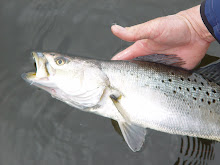



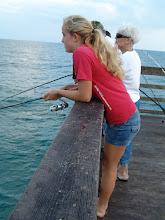

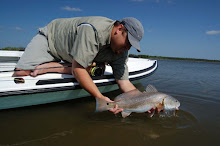.jpg)


